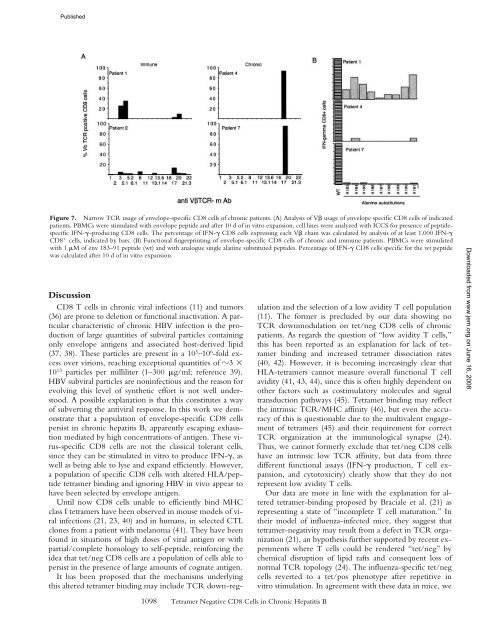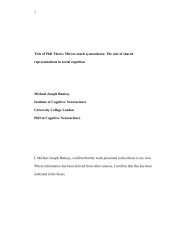Escaping High Viral Load Exhaustion: CD8 Cells with Altered ...
Escaping High Viral Load Exhaustion: CD8 Cells with Altered ...
Escaping High Viral Load Exhaustion: CD8 Cells with Altered ...
Create successful ePaper yourself
Turn your PDF publications into a flip-book with our unique Google optimized e-Paper software.
Published<br />
Figure 7. Narrow TCR usage of envelope-specific <strong>CD8</strong> cells of chronic patients. (A) Analysis of V usage of envelope specific <strong>CD8</strong> cells of indicated<br />
patients. PBMCs were stimulated <strong>with</strong> envelope peptide and after 10 d of in vitro expansion, cell lines were analyzed <strong>with</strong> ICCS for presence of peptidespecific<br />
IFN-–producing <strong>CD8</strong> cells. The percentage of IFN- <strong>CD8</strong> cells expressing each V chain was calculated by analysis of at least 1,000 IFN-<br />
<strong>CD8</strong> cells, indicated by bars. (B) Functional fingerprinting of envelope-specific <strong>CD8</strong> cells of chronic and immune patients. PBMCs were stimulated<br />
<strong>with</strong> 1 M of env 183–91 peptide (wt) and <strong>with</strong> analogue single alanine substituted peptides. Percentage of IFN- <strong>CD8</strong> cells specific for the wt peptide<br />
was calculated after 10 d of in vitro expansion.<br />
Discussion<br />
<strong>CD8</strong> T cells in chronic viral infections (11) and tumors<br />
(36) are prone to deletion or functional inactivation. A particular<br />
characteristic of chronic HBV infection is the production<br />
of large quantities of subviral particles containing<br />
only envelope antigens and associated host-derived lipid<br />
(37, 38). These particles are present in a 10 3 –10 6 -fold excess<br />
over virions, reaching exceptional quantities of 3 <br />
10 13 particles per milliliter (1–300 g/ml; reference 39).<br />
HBV subviral particles are noninfectious and the reason for<br />
evolving this level of synthetic effort is not well understood.<br />
A possible explanation is that this constitutes a way<br />
of subverting the antiviral response. In this work we demonstrate<br />
that a population of envelope-specific <strong>CD8</strong> cells<br />
persist in chronic hepatitis B, apparently escaping exhaustion<br />
mediated by high concentrations of antigen. These virus-specific<br />
<strong>CD8</strong> cells are not the classical tolerant cells,<br />
since they can be stimulated in vitro to produce IFN-, as<br />
well as being able to lyse and expand efficiently. However,<br />
a population of specific <strong>CD8</strong> cells <strong>with</strong> altered HLA/peptide<br />
tetramer binding and ignoring HBV in vivo appear to<br />
have been selected by envelope antigen.<br />
Until now <strong>CD8</strong> cells unable to efficiently bind MHC<br />
class I tetramers have been observed in mouse models of viral<br />
infections (21, 23, 40) and in humans, in selected CTL<br />
clones from a patient <strong>with</strong> melanoma (41). They have been<br />
found in situations of high doses of viral antigen or <strong>with</strong><br />
partial/complete homology to self-peptide, reinforcing the<br />
idea that tet/neg <strong>CD8</strong> cells are a population of cells able to<br />
persist in the presence of large amounts of cognate antigen.<br />
It has been proposed that the mechanisms underlying<br />
this altered tetramer binding may include TCR down-regulation<br />
and the selection of a low avidity T cell population<br />
(11). The former is precluded by our data showing no<br />
TCR downmodulation on tet/neg <strong>CD8</strong> cells of chronic<br />
patients. As regards the question of “low avidity T cells,”<br />
this has been reported as an explanation for lack of tetramer<br />
binding and increased tetramer dissociation rates<br />
(40, 42). However, it is becoming increasingly clear that<br />
HLA-tetramers cannot measure overall functional T cell<br />
avidity (41, 43, 44), since this is often highly dependent on<br />
other factors such as costimulatory molecules and signal<br />
transduction pathways (45). Tetramer binding may reflect<br />
the intrinsic TCR/MHC affinity (46), but even the accuracy<br />
of this is questionable due to the multivalent engagement<br />
of tetramers (45) and their requirement for correct<br />
TCR organization at the immunological synapse (24).<br />
Thus, we cannot formerly exclude that tet/neg <strong>CD8</strong> cells<br />
have an intrinsic low TCR affinity, but data from three<br />
different functional assays (IFN- production, T cell expansion,<br />
and cytotoxicity) clearly show that they do not<br />
represent low avidity T cells.<br />
Our data are more in line <strong>with</strong> the explanation for altered<br />
tetramer-binding proposed by Braciale et al. (21) as<br />
representing a state of “incomplete T cell maturation.” In<br />
their model of influenza-infected mice, they suggest that<br />
tetramer-negativity may result from a defect in TCR organization<br />
(21), an hypothesis further supported by recent experiments<br />
where T cells could be rendered “tet/neg” by<br />
chemical disruption of lipid rafts and consequent loss of<br />
normal TCR topology (24). The influenza-specific tet/neg<br />
cells reverted to a tet/pos phenotype after repetitive in<br />
vitro stimulation. In agreement <strong>with</strong> these data in mice, we<br />
Downloaded from www.jem.org on June 16, 2008<br />
1098 Tetramer Negative <strong>CD8</strong> <strong>Cells</strong> in Chronic Hepatitis B
















